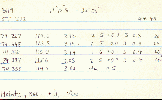



Four observations of ADS 8119 (= HR 4374/4375 = STF 1523 = Xi Ursae Majoris) from Worley (1978) were selected. Observations from a single night are found on a single paper tape output. The last line of these dates is a six-digit number in a format yymmdd which gives the date of the observation. This is converted to the Besselian year, usually on the tape, and these correspond to a single entry.
Four observations were made of ADS 8119 in the Spring, 1974 observing season. Scans of these four outputs is provided in Figures 1-4 below.




The output of an observation consists of at least twelve lines. Outputs for the twelve lines will be explained below:
The next set of numbers correspond to the uncalibrated position angle. The mean of these is modified by the current beta correction. This would be modified every time the micrometer was taken off or put on the telescope. For all of these observations, the beta is -6.6 degrees.
 Each four of these reduced measures is transferred to an index card (at right).
for each target per season. These lines correspond almost exactly to the output
seen in Worley (1978). Note that, in the case of the 1974.348 observation (which
corresponds to Figure 2), the position angle (which was measured five times) is
given a ``:'' indicating a measure of lesser quality. However, it does not seem
to be weighted less in the determination of the mean. It is possible that were
it significantly different from the other values that it may have been given
lesser or zero weight. Finally, the mean is determined, and residuals are
calculated from a published orbit [in this case, Heintz 1966 (actually 1967)].
The mean (which is actually comes from twelve measures) is the final value which
is used in orbit determinations and is placed in the WDS.
Each four of these reduced measures is transferred to an index card (at right).
for each target per season. These lines correspond almost exactly to the output
seen in Worley (1978). Note that, in the case of the 1974.348 observation (which
corresponds to Figure 2), the position angle (which was measured five times) is
given a ``:'' indicating a measure of lesser quality. However, it does not seem
to be weighted less in the determination of the mean. It is possible that were
it significantly different from the other values that it may have been given
lesser or zero weight. Finally, the mean is determined, and residuals are
calculated from a published orbit [in this case, Heintz 1966 (actually 1967)].
The mean (which is actually comes from twelve measures) is the final value which
is used in orbit determinations and is placed in the WDS.
References: